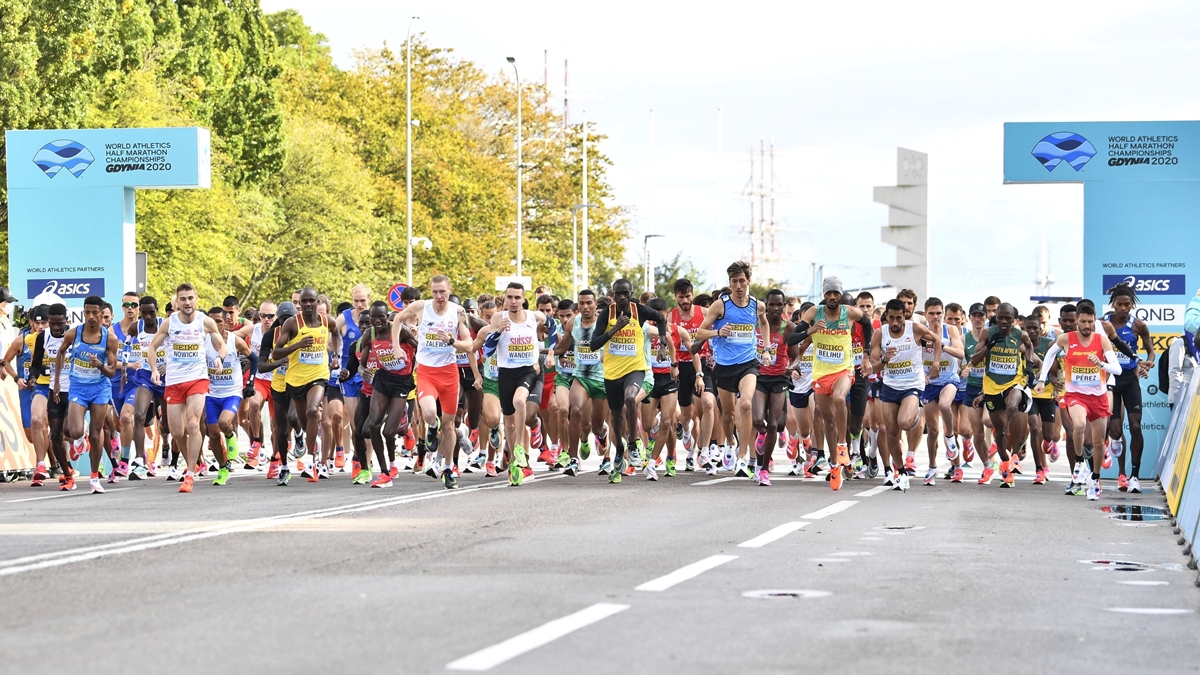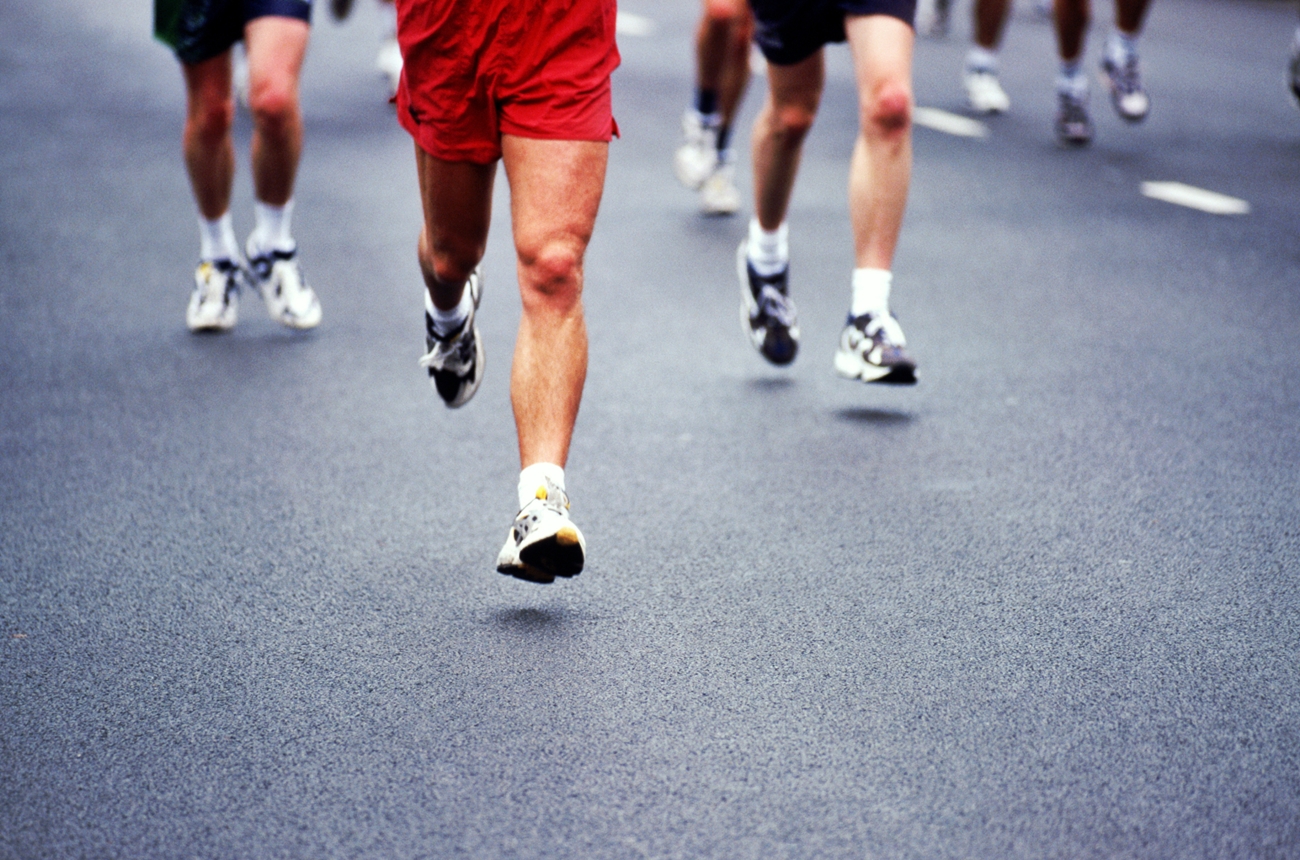Home>Misc>Featured>Training For A Half Marathon When You Can’t Run


Featured
Training For A Half Marathon When You Can’t Run
Modified: January 22, 2024
Discover how to train for a half marathon when you can't run with our featured training program, designed for all fitness levels.
Introduction
Training for a half marathon is a challenging yet rewarding endeavor. Whether you’re a seasoned runner or new to the world of long-distance races, the half marathon distance of 13.1 miles presents an exciting opportunity to test your endurance and push your limits. However, not everyone is able to run due to various reasons such as injuries, physical limitations, or personal preferences. But fear not! If you find yourself unable to run, there are still ways to train effectively for a half marathon and participate in this amazing event.
In this article, we will explore alternative methods of training for a half marathon when running is not an option. We will discuss the benefits of training for a half marathon, share tips on overcoming running limitations, delve into alternative cardiovascular exercises and strength training, and provide guidance on nutrition, hydration, mental preparation, and injury prevention. By the end of this article, you will have a comprehensive understanding of how to prepare for a half marathon, even if running is not your primary form of training.
Participating in a half marathon offers numerous benefits beyond just the physical aspect. It allows you to set a goal, challenge yourself, and experience a sense of accomplishment upon crossing the finish line. Whether your goal is to complete the race, improve your personal best time, or just enjoy the journey, the training process will not only improve your overall fitness but also boost your mental resilience and determination.
Now, let’s explore the various ways you can effectively train for a half marathon, regardless of whether running is an option for you or not. So, lace up your shoes, get ready to sweat, and let’s embark on this marathon training journey together!
Benefits of Training for a Half Marathon
Training for a half marathon offers a multitude of benefits, both physical and mental. While the thought of running 13.1 miles may seem daunting, the journey towards achieving this goal is a transformative experience that can positively impact various aspects of your life. Here are some of the key benefits of training for a half marathon:
- Improved cardiovascular fitness: The demanding nature of a half marathon requires your heart and lungs to work harder, resulting in improved endurance and cardiovascular fitness. Regular training helps strengthen your heart muscle, lowers resting heart rate, and increases the efficiency of oxygen and nutrient delivery to your working muscles.
- Weight management: Half marathon training involves consistent aerobic exercise, which can help burn calories and contribute to weight loss or weight maintenance. Combined with a balanced diet, training for a half marathon can support your overall weight management goals.
- Increased energy levels: Engaging in regular exercise, such as half marathon training, stimulates the production of endorphins, the “feel-good” hormones. As a result, you may experience increased energy levels and improved mood throughout your training journey.
- Enhanced mental well-being: Training for a half marathon requires discipline, focus, and perseverance. As you overcome challenges and push through difficult training sessions, you develop mental strength and resilience. This can lead to reduced stress levels, improved self-confidence, and enhanced overall mental well-being.
- Social connections: Participating in half marathon training programs or joining running groups provides an opportunity to connect with like-minded individuals who share your passion for running. This sense of community and support can be incredibly motivating and may even lead to lifelong friendships.
- Goal-setting and achievement: Training for a half marathon allows you to set clear goals and work towards achieving them. This process instills a sense of purpose, boosts self-esteem, and provides a tangible accomplishment when you cross the finish line on race day.
As you can see, training for a half marathon offers a wide range of benefits that extend far beyond just physical fitness. It has the power to transform your mindset, improve your overall well-being, and provide a sense of accomplishment that carries over into other areas of your life. So, whether you’re a seasoned runner or new to the sport, committing to a half marathon training program can have a lasting positive impact on your health and happiness.
Overcoming Running Limitations
Running limitations can arise due to various factors such as injuries, physical limitations, or personal preferences. However, these limitations should not deter you from training for a half marathon. There are several strategies you can employ to overcome running limitations and still prepare effectively for the race. Here are some tips to help you overcome running limitations:
- Cross-training: If running is not an option for you, cross-training is an excellent alternative. Engaging in low-impact activities such as cycling, swimming, or using an elliptical machine can provide cardiovascular benefits similar to running while minimizing the stress on your joints. Incorporate cross-training sessions into your training plan to maintain your aerobic fitness and improve overall endurance.
- Walk-run intervals: If you have a physical limitation or are new to running, incorporating walk-run intervals into your training can be beneficial. Alternate between walking and jogging or running in specific time intervals. Gradually increase the running duration over time to build up your endurance and fitness level.
- Aquatic exercises: Water-based exercises, such as water jogging or pool running, can be a great option for individuals with joint issues or injuries. The buoyancy of the water reduces the impact on your joints while still providing a challenging workout. Consider incorporating aquatic exercises into your training regimen to improve cardiovascular fitness and maintain muscle strength.
- High-intensity interval training (HIIT): HIIT workouts are short, intense bursts of exercise alternated with periods of rest. These workouts can be done using various exercises such as cycling, rowing, or bodyweight exercises. HIIT not only improves cardiovascular fitness but also helps build endurance and strength. Include HIIT sessions in your training plan to maximize your fitness gains within a shorter period.
- Work with a physical therapist or coach: If you have a specific injury or limitation, it’s crucial to seek guidance from a qualified professional. A physical therapist or running coach can assess your situation, provide targeted exercises or modifications, and help you create a training plan that accommodates your limitations while still preparing you for the half marathon.
Remember, everyone’s running journey is unique, and it’s essential to listen to your body and adapt your training accordingly. Pushing through limitations doesn’t mean ignoring pain or risking further injury. It’s about finding alternate methods that allow you to continue your half marathon training while prioritizing your safety and well-being. By incorporating these strategies and being creative with your training approach, you can conquer your running limitations and achieve your half marathon goals.
Alternative Cardiovascular Exercises
When running is not an option, there are numerous alternative cardiovascular exercises that can help you build endurance, improve cardiovascular fitness, and prepare for a half marathon. These exercises offer a variety of options to challenge your cardiovascular system and keep your training exciting. Here are some alternative cardiovascular exercises to consider incorporating into your training routine:
- Cycling: Cycling is a low-impact exercise that targets the muscles in your legs, engages your cardiovascular system, and builds endurance. Whether you prefer outdoor cycling or using a stationary bike, incorporating regular cycling sessions into your training routine can provide a challenging cardiovascular workout while being gentle on your joints.
- Swimming: Swimming is a full-body workout that engages multiple muscle groups while providing a low-impact cardiovascular exercise. It helps enhance lung capacity, build endurance and strength, and improve overall cardiovascular fitness. Consider adding swimming sessions to your training plan to vary your workouts and give your joints a break.
- Rowing: Rowing is an excellent full-body exercise that engages both the upper and lower body muscles, making it a great alternative cardiovascular exercise for cross-training. Rowing machines, also known as ergometers, provide a challenging workout that helps improve cardiovascular endurance and muscular strength.
- Elliptical training: Using an elliptical machine provides a low-impact, yet effective, cardiovascular workout. It mimics the motion of running without putting excessive stress on your joints. The elliptical trainer targets your lower body muscles and engages your cardiovascular system, making it a suitable alternative for half marathon training.
- Dancing: Dancing is not only a fun and enjoyable activity but also a great way to get your heart rate up and improve cardiovascular fitness. Whether it’s Zumba, hip-hop, or any other dance style, incorporating dance sessions into your training routine can help improve endurance, coordination, and overall cardiovascular health.
It’s important to note that while these alternative cardiovascular exercises can be effective in preparing for a half marathon, they may not perfectly replicate the impact and intensity of running. Therefore, it’s essential to incorporate some running-specific sessions into your training plan whenever possible to build the necessary running-specific endurance and technique.
Remember, the key is to find activities that you enjoy and that align with your fitness goals and limitations. Mix and match different exercises to keep your training varied and engaging. By incorporating alternative cardiovascular exercises into your training routine, you can continue to improve your endurance, strengthen your cardiovascular system, and progress toward your half marathon goals, even if running isn’t your primary focus.
Strength Training for Half Marathon Preparation
While cardiovascular training is crucial for half marathon preparation, incorporating strength training into your routine is equally important. Strength training helps improve overall muscular strength, endurance, and stability, which are essential for running efficiency and injury prevention. Here are some key points to consider when integrating strength training into your half marathon preparation:
- Focus on lower body exercises: Since running primarily utilizes the muscles in your lower body, it’s important to prioritize exercises that target these muscle groups. Squats, lunges, deadlifts, calf raises, and hip bridges are all excellent choices to strengthen your quadriceps, hamstrings, calves, and glutes.
- Incorporate core exercises: A strong core provides stability and helps maintain proper running form. Planks, Russian twists, bicycle crunches, and Superman exercises are effective ways to strengthen your abdominal, lower back, and hip muscles.
- Include upper body exercises: Although running predominantly involves your lower body, having a strong upper body can improve your overall posture and arm swing, leading to more efficient running. Push-ups, rows, shoulder presses, and bicep curls are examples of upper body exercises you can incorporate into your strength training routine.
- Use proper form and technique: When performing strength exercises, it’s crucial to maintain proper form and technique to minimize the risk of injury. If you are unsure about the correct form, consider consulting a personal trainer or watching instructional videos to ensure you are using proper technique for each exercise.
- Vary your exercises and add resistance: To challenge your muscles and continue making progress, it’s important to vary your strength exercises. This can include using different equipment like resistance bands, dumbbells, or kettlebells. Additionally, progressively increasing the resistance or weight as you get stronger will help stimulate further muscle growth and development.
- Include balance and stability exercises: Half marathon runners require good stability and balance to navigate uneven terrain. Incorporating exercises like single-leg squats, balance boards, or stability ball exercises can help improve your balance and stability, reducing the risk of falls and injuries during your training.
It’s important to note that strength training should complement your running workouts, not replace them. Aim to incorporate two to three strength training sessions per week, with at least 48 hours of rest between sessions. This will give your muscles adequate time to recover and adapt to the training stimulus.
By integrating strength training into your half marathon preparation, you will not only enhance your running performance but also reduce the risk of muscle imbalances, overuse injuries, and fatigue. Remember to listen to your body, start with weights or resistance that are appropriate for your fitness level, and gradually increase the intensity as you progress. With a well-rounded training program that includes both cardiovascular and strength exercises, you’ll be well-prepared for the physical demands of a half marathon.
Cross-Training Activities
Cross-training involves incorporating different types of exercises and activities into your training routine to complement your primary form of exercise, such as running. Engaging in cross-training activities can help improve overall fitness, prevent injuries, and provide a refreshing change of pace. Here are some popular cross-training activities to consider incorporating into your half marathon training:
- Swimming: Swimming provides a low-impact, full-body workout that helps build cardiovascular fitness and improve muscular strength and endurance. It offers a break from the repetitive impact of running while providing a challenging workout that can complement your half marathon training.
- Cycling: Cycling is another great cross-training activity that improves cardiovascular fitness and builds lower body strength. Whether it’s outdoor cycling or using a stationary bike, cycling engages different muscles than running and provides a low-impact alternative to complement your training.
- Yoga: Incorporating yoga into your training routine can help improve flexibility, balance, and core strength. It also promotes relaxation and aids in recovery, which is crucial during the rigorous training period leading up to a half marathon.
- Pilates: Pilates focuses on developing core strength, stability, and flexibility. The controlled movements and emphasis on proper alignment can benefit runners by improving posture, reducing the risk of injuries, and enhancing overall body awareness.
- High-intensity interval training (HIIT): HIIT workouts involve short bursts of intense exercise followed by periods of active recovery. HIIT can be done with various exercises, such as bodyweight exercises, plyometrics, or cardio drills. Incorporating HIIT sessions into your training can improve your cardiovascular fitness, boost metabolism, and enhance overall performance.
- Strength training: We have already covered the importance of strength training, but it’s worth emphasizing its role as a cross-training activity. Whether it’s using weights, resistance bands, or bodyweight exercises, strength training helps improve muscular strength, stability, and endurance, which are essential for optimal performance during a half marathon.
When incorporating cross-training activities into your training plan, remember to consider your overall training volume and recovery needs. Balance your training schedule to ensure adequate rest and recovery between workouts, as well as a gradual progression in terms of intensity and duration. Most importantly, choose activities that you genuinely enjoy, as this will help maintain your motivation and make your training more enjoyable.
By including cross-training activities in your half marathon preparation, you’ll not only enhance your overall fitness but also reduce the risk of overuse injuries and burnout. Mixing up your training routine with different activities keeps things interesting and challenges your body in new ways. So, don’t be afraid to explore and experiment with various cross-training activities to supplement your running and prepare yourself for an amazing half marathon experience.
Nutrition and Hydration Tips for Half Marathon Training
Proper nutrition and hydration are essential for maximizing your performance and supporting your body’s needs during half marathon training. The right fuel can help optimize your energy levels, aid in recovery, and enhance your overall training experience. Here are some key nutrition and hydration tips to consider during your half marathon training:
- Stay hydrated: Adequate hydration is crucial for optimal performance. Drink water throughout the day and especially during and after your workouts. Monitor your urine color; if it’s pale yellow, you’re well-hydrated, whereas dark yellow indicates dehydration.
- Carbohydrates for energy: Carbohydrates are the primary fuel source for endurance activities. Prioritize complex carbohydrates such as whole grains, fruits, vegetables, and legumes in your diet. These provide sustained energy and support glycogen stores in your muscles.
- Protein for recovery and muscle repair: Protein plays a vital role in muscle repair and recovery. Include lean protein sources like chicken, fish, eggs, dairy, or plant-based options such as tofu, beans, and lentils in your meals and snacks.
- Balance your macronutrients: Aim for a balanced diet that includes a variety of nutrients. Include healthy fats from sources like avocado, nuts, and olive oil, as well as adequate fiber from whole grains, fruits, and vegetables.
- Eat before and after workouts: Fuel your body with a small meal or snack containing carbohydrates and some protein before your workouts to provide energy. After your workouts, consume a balanced meal within an hour or two to replenish glycogen stores and aid in muscle recovery.
- Experiment during training: Training is the perfect time to experiment with different foods and timing to find what works best for your body. Everyone’s nutritional needs are different, so pay attention to your body’s signals and adjust your fueling strategy accordingly.
- Consider electrolyte replacement: During long runs or in hot weather, electrolytes and minerals like sodium, potassium, and magnesium can be lost through sweat. Consider including electrolyte drinks or supplements to maintain electrolyte balance and prevent cramping.
Remember, nutrition and hydration are not just important on race day – they are crucial throughout your entire training period. Practice your nutrition and hydration strategies during long runs or training sessions to identify what works best for you. And don’t forget to listen to your body’s signals of hunger and thirst and adjust your intake accordingly.
It’s also wise to consult a registered dietitian or sports nutritionist to create a personalized nutrition plan that suits your specific needs and goals. They can provide guidance on portion sizes, meal timing, and specific dietary considerations to optimize your half marathon training.
By fueling your body with the right nutrition and staying properly hydrated, you’ll have the energy and stamina to tackle your training runs, recover effectively, and perform at your best on race day. So, prioritize your nutrition and make it an integral part of your half marathon training journey.
Mental Preparation and Goal Setting
Training for a half marathon is not just a physical challenge, but also a mental one. Developing a strong mindset and setting clear goals are vital components of a successful training journey. Here are some tips for mental preparation and goal setting that will help you stay motivated and focused throughout your half marathon training:
- Set SMART goals: SMART stands for Specific, Measurable, Achievable, Relevant, and Time-bound. Set clear and specific goals that are challenging yet realistic. Break your training down into smaller milestones to track your progress and stay motivated as you work towards your ultimate goal.
- Visualize success: Visualization is a powerful tool that can help you mentally prepare for the half marathon. Imagine yourself crossing the finish line, feeling strong and accomplished. Visualize the challenges you may face during training and how you will overcome them with determination and resilience.
- Practice positive self-talk: Monitor your inner dialogue and replace any negative thoughts with positive affirmations. Remind yourself of your capabilities, strengths, and progress. Focus on the process rather than solely on the outcome, celebrating each step forward along the way.
- Stay motivated: Find ways to stay motivated throughout your training. This could include creating a motivating playlist, joining a running group, or finding a training partner. Surround yourself with positive influences and immerse yourself in inspirational stories or articles about other runners’ achievements.
- Embrace the journey: Training for a half marathon is not just about reaching the finish line; it’s about the entire journey. Embrace the ups and downs, the challenges and milestones. Appreciate the lessons you learn, the progress you make, and the personal growth that accompanies the training process.
- Practice mindfulness: Incorporate mindfulness techniques such as deep breathing, meditation, or yoga into your routine. These practices can help reduce stress, improve focus, and enhance your overall well-being, allowing you to approach your training with a calm and centered mindset.
- Seek support: Surround yourself with a supportive network of friends, family, or fellow runners who understand and encourage your goals. Share your journey with them, seek advice and motivation when needed, and celebrate your achievements together.
Remember, your mind can be your most powerful asset during the half marathon training process. Cultivating a positive and determined mindset will not only help you overcome obstacles but also enjoy the journey and find fulfillment in the entire experience.
In addition to setting goals and preparing mentally, it’s important to be flexible and adaptable. Recognize that there may be unexpected challenges and adjustments along the way. Be open to modifying your goals or training plan if necessary, while remaining focused on your overall vision of completing the half marathon.
By nourishing your mental well-being and setting clear goals, you will develop the mental fortitude needed to push through the tough moments and achieve your potential. Embrace the power of your mind, believe in yourself, and let your mental strength propel you towards half marathon success.
Injury Prevention and Recovery Strategies
Prioritizing injury prevention and implementing effective recovery strategies are essential components of successful half marathon training. Here are some key tips and strategies to help you stay injury-free and recover effectively throughout your training:
- Gradual training progression: Gradually increase your training volume and intensity to allow your muscles, tendons, and joints to adapt. Avoid sudden spikes in training load, as this can lead to overuse injuries. Follow a structured training plan that includes rest days and gradual increases in mileage or intensity.
- Proper warm-up and cool-down: Always begin your workouts with a dynamic warm-up, which includes dynamic stretches and exercises that mimic the movements of running. After your run, cool down with static stretches to improve flexibility and aid in muscle recovery.
- Listen to your body: Pay attention to any warning signs of pain or discomfort. If you experience persistent pain or unusual sensations, adjust your training or seek medical attention if necessary. Ignoring or pushing through pain can lead to more serious injuries.
- Strength and mobility training: Strengthening your muscles helps support your joints and reduce the risk of injuries. Incorporate exercises that target the muscles used in running, as well as those that improve stability and mobility. Prioritize functional exercises that mimic the movements of running and focus on proper form.
- Cross-train and rest: Cross-training activities, such as swimming or cycling, can help reduce the risk of overuse injuries by diversifying your training load. Additionally, rest days are crucial for allowing your body to recover and repair. Listen to your body, rest when needed, and avoid overtraining.
- Adequate sleep and nutrition: Getting enough sleep and following a balanced diet are crucial for recovery and injury prevention. Sleep allows your body to regenerate and repair tissues, while a nutritious diet provides the essential nutrients your body needs for optimal performance and recovery.
- Hydration and fueling: Proper hydration and fueling are vital for maintaining energy levels and preventing muscle cramps and fatigue. Prioritize drinking water throughout the day and during your runs, and replenish electrolytes with sports drinks or electrolyte supplements as needed.
- Self-care and recovery techniques: Utilize recovery techniques such as foam rolling, massage, stretching, and ice baths to alleviate muscle soreness, reduce inflammation, and promote faster recovery. Listen to your body’s recovery needs and incorporate these techniques into your routine as necessary.
- Get professional help when needed: If you experience persistent pain or suspect an injury, don’t hesitate to seek professional help from a sports medicine specialist, physical therapist, or a qualified healthcare provider. Prompt treatment and rehabilitation can help prevent further complications and ensure a quicker recovery.
Remember, prevention is key when it comes to injuries. By incorporating these strategies into your training routine, you can minimize the risk of injuries and stay on track to achieving your half marathon goals. The key is to prioritize your body’s well-being, listen to its signals, and make rest and recovery an integral part of your training plan.
Conclusion
Training for a half marathon can be a challenging and rewarding journey, regardless of whether running is an option for you or not. By adapting your training approach and incorporating alternative methods, you can still achieve your goals and participate in this incredible event. Throughout this article, we explored various aspects of half marathon training, including the benefits of training, overcoming running limitations, alternative cardiovascular exercises, strength training, cross-training activities, nutrition and hydration tips, mental preparation, and injury prevention and recovery strategies.
Half marathon training goes beyond physical fitness – it tests your mental resilience, determination, and goal-setting abilities. By setting SMART goals, visualizing success, practicing positive self-talk, and embracing the journey, you can cultivate the mindset needed to conquer the half marathon distance. When it comes to physical training, cross-training activities, strength training, and varied cardiovascular exercises serve as effective alternatives to running, allowing you to build endurance and improve overall fitness.
Proper nutrition, hydration, and recovery techniques are vital aspects of your training. Fueling your body with the right nutrients, staying hydrated, and implementing injury prevention and recovery strategies contribute to your overall performance and well-being. Additionally, taking care of your mental and emotional health through mindfulness techniques, seeking support, and staying motivated will enhance your training experience.
As you embark on your half marathon journey, remember that everyone’s path is unique. It’s important to listen to your body, adapt your training as needed, and seek professional advice when necessary. Be patient, celebrate your progress, and focus on the process rather than solely on the outcome. Whether you’re a first-time half marathoner or a seasoned runner, embrace the challenge, enjoy the journey, and revel in the incredible sense of accomplishment that awaits you at the finish line.









